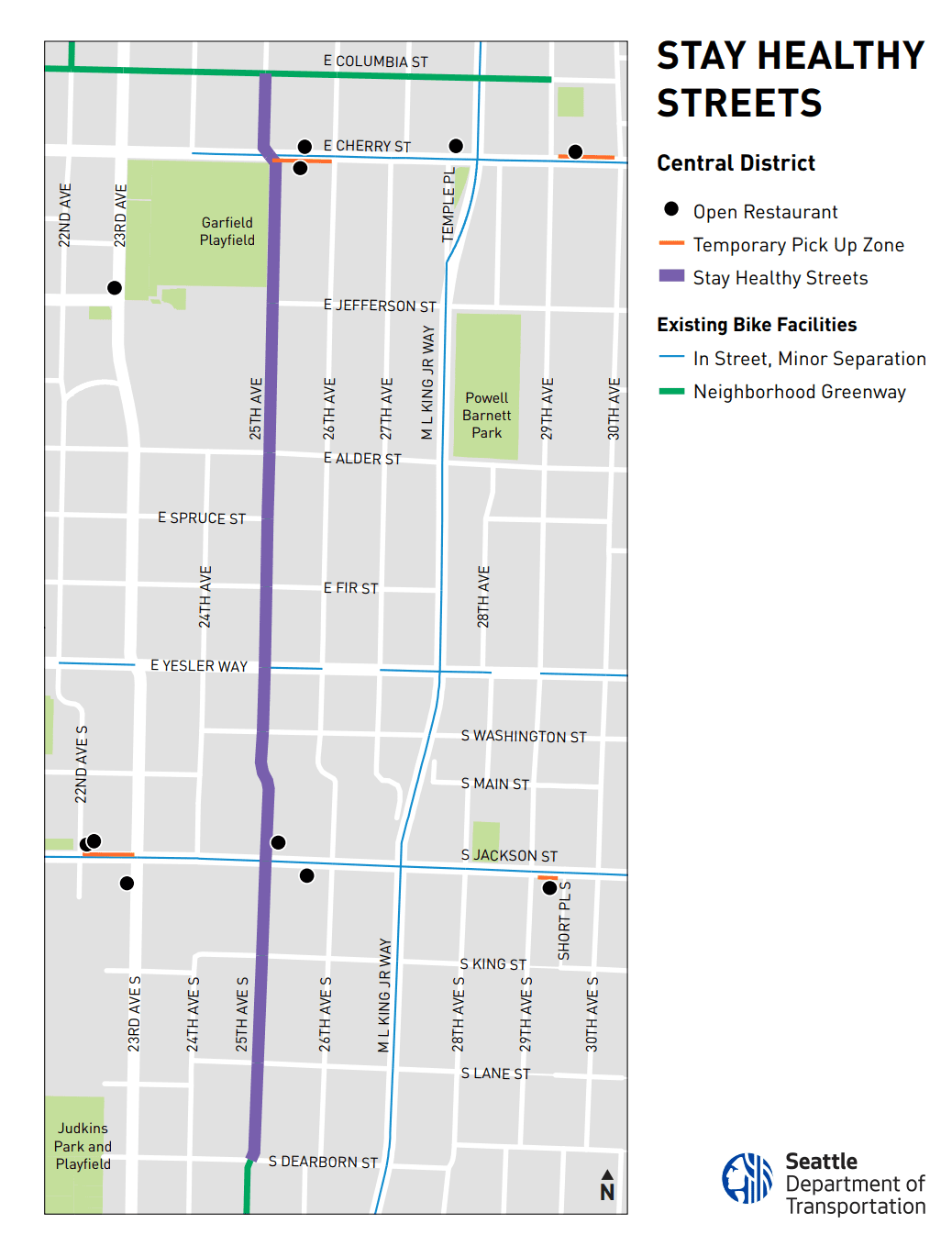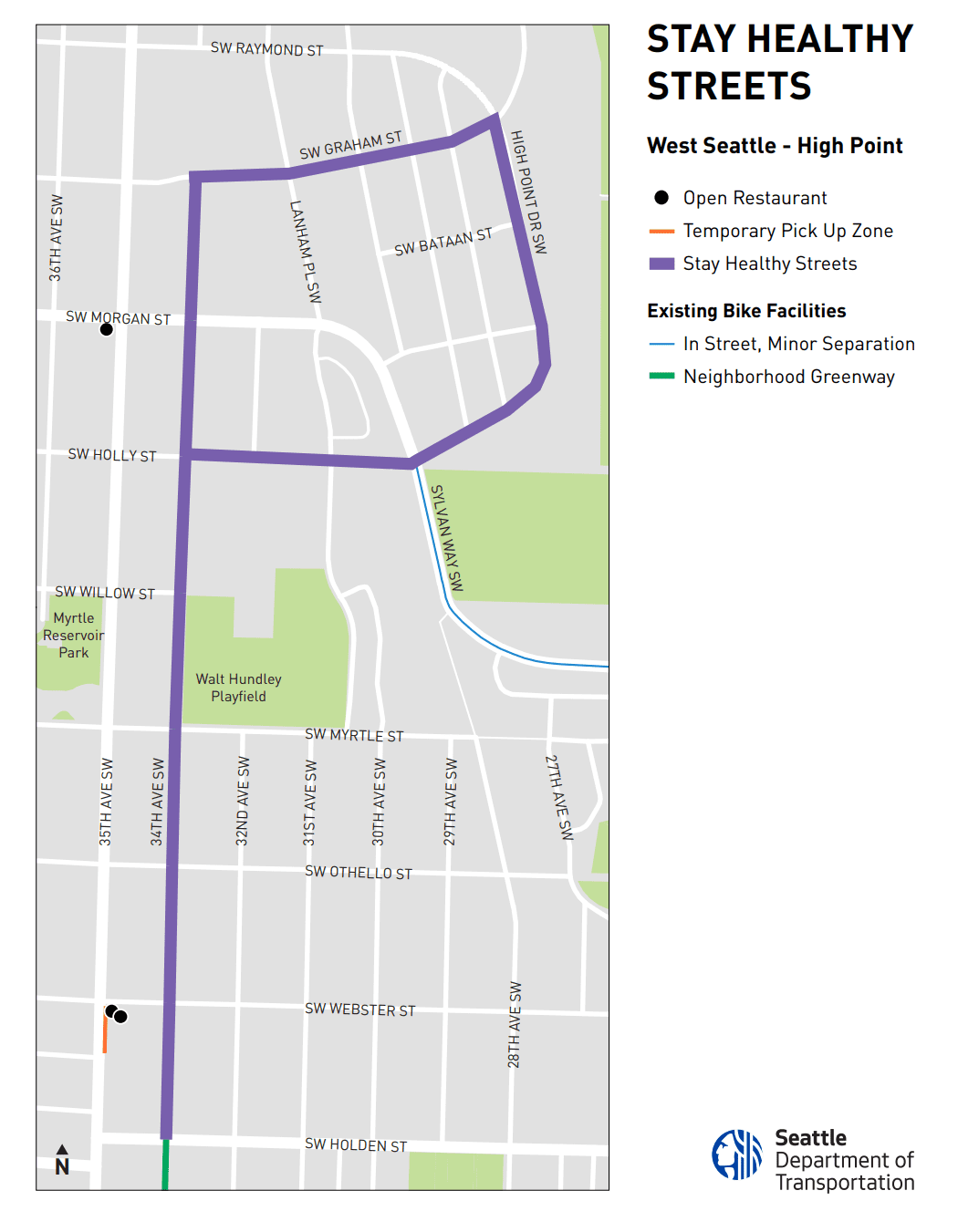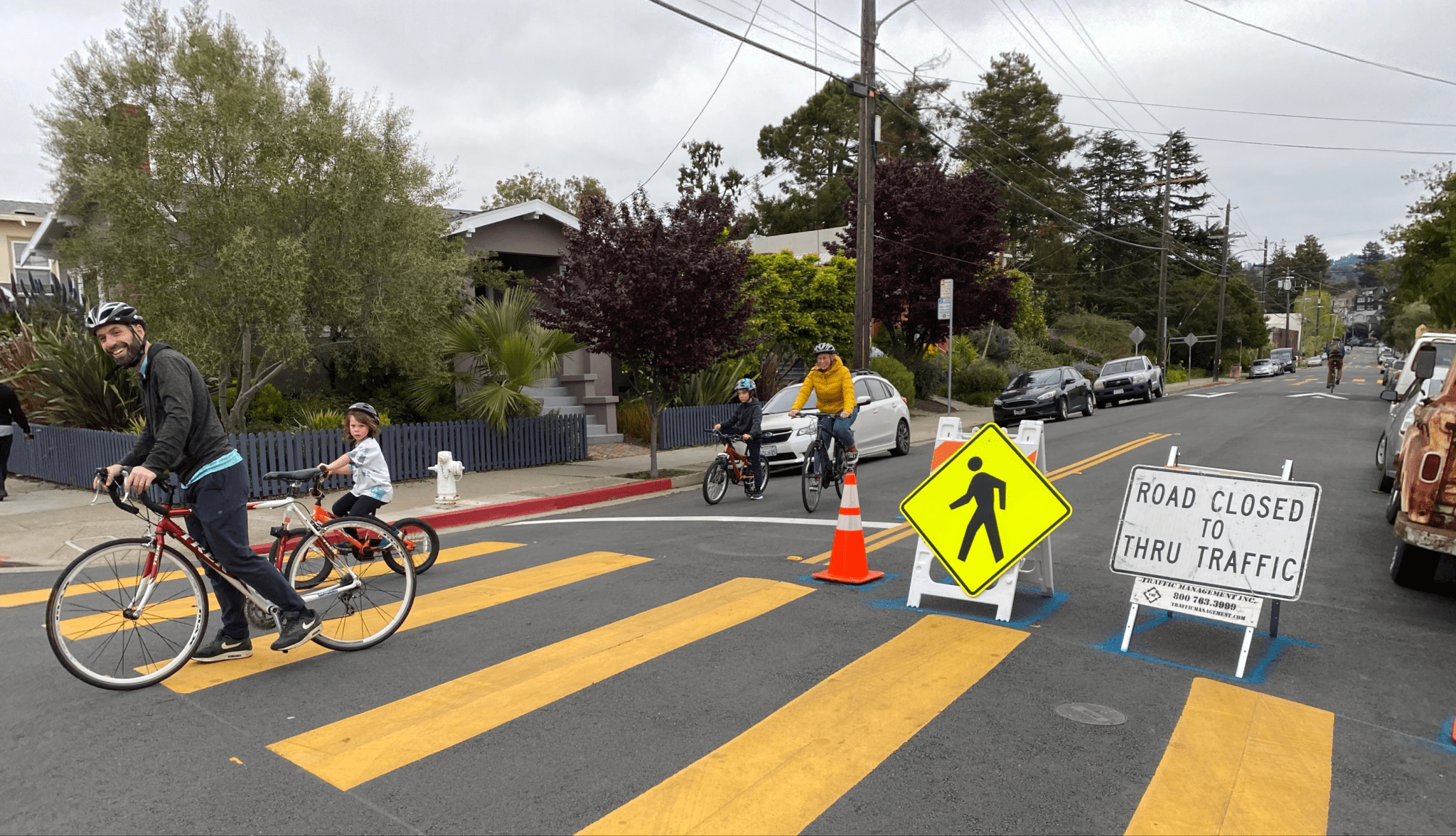 Oakland Slow Streets, photo courtesy of City of Oakland https://s3.us-west-2.amazonaws.com/cao-94612/galleries/Shafter-42nd_Family.png
Oakland Slow Streets, photo courtesy of City of Oakland https://s3.us-west-2.amazonaws.com/cao-94612/galleries/Shafter-42nd_Family.png Walk, roll, and bike locally while keeping six feet apart
Like the rest of the world, here in Seattle we’re rethinking how we live and move around our city during the COVID 19 crisis. Today Mayor Durkan announced new guidelines to allow continued use of parks, farmers markets, and neighborhood greenways that are closed to thru-traffic.
Starting this weekend, Seattle will close portions of two neighborhood greenways to thru-traffic so people can bike and walk in the road, we’re calling them Stay Healthy Streets. Local traffic is still allowed on the streets. We’re also asking everyone to #KeepItMoving while using public amenities such as parks, greenways and farmers markets.
“The social distancing necessary to keep us healthy will mean a new normal for Seattle’s parks, farmers markets, and public amenities. Stay home, but if you need to exercise or go to get groceries at the farmers market, please keep it moving,” said Mayor Jenny Durkan. “We know that this virus isn’t leaving our community for a long time, but I am hopeful that Seattle can adapt. I’m asking every Seattle resident: think of the nurses and health care workers on the front lines before you leave the house.”
“To support safe social distancing while exercising or walking, rolling, biking to grocery stores or food pick-up, we’re converting portions of existing neighborhood greenways into Stay Healthy Streets over the next few weeks,” said Sam Zimbabwe, SDOT Director. “We hope the effort keeps people moving and enjoying the spring weather during this tough time.”
This weekend we’re launching with about 2.5 miles in the Central District and West Seattle/High Point.
Portions of neighborhood greenways along 25th Ave S and 34th Ave SW/SW Graham and Holly St/High Point Dr SW are opening to people living in the neighborhood for walking, rolling, and biking.
These streets were selected to amplify outdoor exercise opportunities for areas with limited open space options, low car ownership and routes connecting people to essential services and food take out. We also ensured street closures did not impact newly opened food pick up loading zones, parking around hospitals for service for health care professionals, and bus routes.
After an initial evaluation, we are aiming to convert approximately 15 miles to Stay Healthy Streets in the coming weeks. We will continue to re-evaluate after this weekend’s pilot and work with community and stakeholders on additional suggestions and recommendations. Additional closures will be subject to change based on additional orders, construction, and availability of our crews and signs.
Seattle has 196 miles total of bike lanes, trails, and neighborhood greenways.
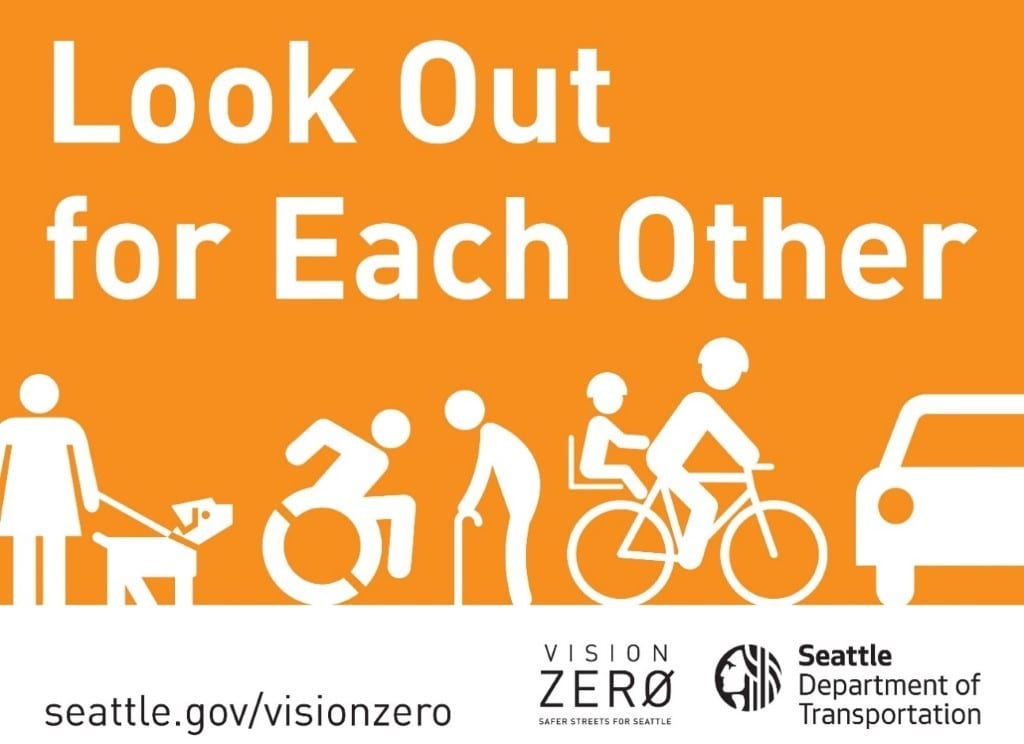
Stay Healthy Streets are closed to thru-traffic – but not residents or deliveries – 24 hours a day, seven days a week for the duration of the emergency or until otherwise noted by the City of Seattle.
People with destinations along Stay Healthy Streets – like residents, essential workers, emergency service providers, delivery providers, and garbage and recycling collectors will continue to have vehicle access.
“Stay Healthy Streets is a smart initiative by the Mayor and SDOT to give people sufficient space to safely walk, bike, and roll for exercise and essential transportation. This is important for both our physical and mental health, and to help save money when things are tight for so many right now (transportation is a major household cost, second only to housing). We look forward to seeing these streets expanded to neighborhoods across the city,” said Gordon Padelford, Executive Director of Seattle Neighborhood Greenways.
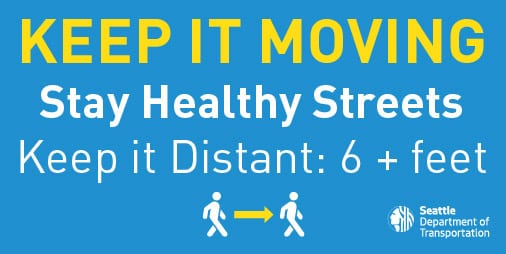
When using the Safe Healthy Streets for physical activity, please follow King County and Seattle Public Health guidelines and our #KeepitMoving guidance. Keep six feet apart, wear face masks if you have them, and don’t spit—seriously, don’t do it.
Keep it Moving Guidance:
- Stay Home. If you need to leave the house, visit your neighborhood park.
- Keep it Moving: Keep, walking, running, or biking. That means no picnics, no BBQs, no sports, no gatherings at our parks.
- Visit parks, greenways and farmers markets at off peak hours.
- If you see a crowd, go somewhere else
“We owe it to our heroes on the frontlines to take extra precaution when we walk out the door,” said Councilmember Debora Juarez. “Keep moving and enjoy the sunshine safely. As long as we continue practicing safe social distancing and appropriate COV-etiquette – wearing a mask, washing hands, staying 6+ feet apart – we will ALL be able to keep this disease at bay.“
On Friday, people will start seeing street closure signs at all intersections along the first two Stay Healthy Streets.
We’ll place signs to the right of intersections so people living on a Safe Healthy Street are able to drive in and out of their neighborhoods.
We’re also seeking volunteers to confirm road closure signs are still in place and conduct pedestrian and bicycling counts. Those interested in volunteering can email NorthSeattleGreenway@Seattle.gov. The counts will be used to monitor the success of Stay Healthy Streets, along with resident feedback, and any traffic impacts where vehicles are detoured.
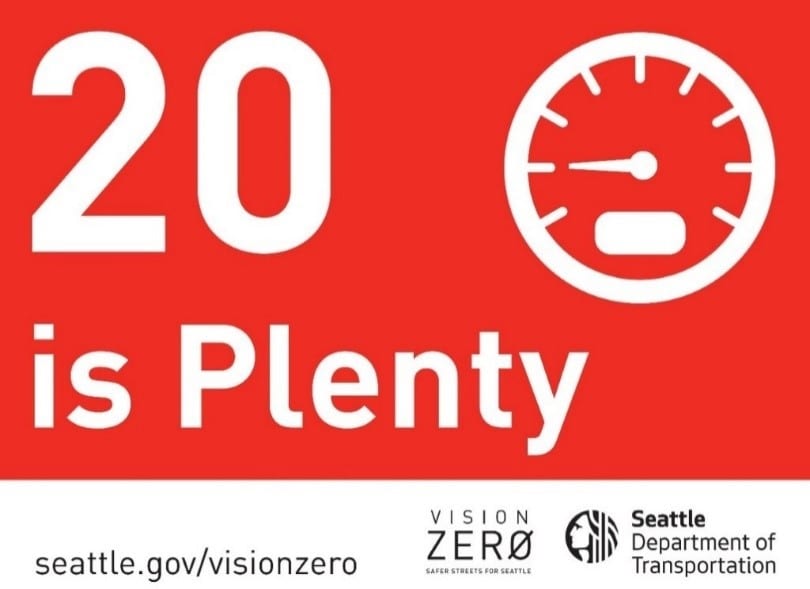
No matter how you’re traveling, help everyone get to their destinations safely.
As always, people driving should observe the 20MPH speed limits, put phones down, and watch out for each other to avoid crashes and serious injuries. Download, print, and post an 11 x 8.5 poster reminding people driving that 20 is plenty, and to look out for each other.
- Be predictable
- Only drive on Safe Healthy Streets if your destination is on it
- Stay alert at all times; don’t be distracted by electronic devices that take your eyes (and ears) off the road
- Make eye contact with people walking, biking and driving as they approach to make sure you are seen
